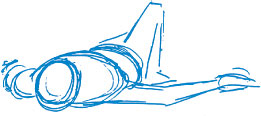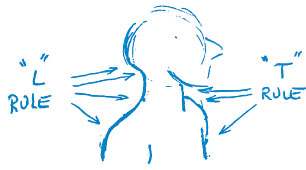66 Applying the Rules of Perspective
Whenever I think of drawing, my thoughts go back to those principles of perspective I mentioned a while back. The more I think about them, the more I come to believe they ought to be called the “All encompassing principles of drawing.” I never make a drawing without being conscious of them, and when I am having trouble with a drawing, I delve into those rules and they are a sure help. For those of you who were not privy to those simple but very valuable rules (which I “borrowed” from Bruce McIntyre), here they are.

Take the one about diminishing size. That has to do with establishing a vanishing point on the horizon and having all things diminish in size from an established height in the foreground to that vanishing point. In animation we work with a layout that has that kind of perspective built in, so we have to draw our characters with a somewhat matching perspective. Let’s consider how these rules may be used to accomplish a desired third dimensional effect. This may seem like an unlikely approach, but let’s take five dimes (minus the detail). Knowing they are all the same size, if we drew them all the same size, they would all appear to be the same distance from us.

If we varied the sizes they would appear to be at different distances from us (rule: “diminishing size”).

If we put two of them side by side, we create and are aware of the space between them (two-dimensional space).
![]()
Now if we place one behind the other (rule overlap) plus making one of them diminished in size (one of the rules of perspective). we create a third dimensional negative space.

If we take just one portion of our dime drawing, we would have what I once saw in a book on drawing, the “T” principle.

There will be numerous occasions where we can use the whole dime thing, for instance, in foreshortening the figure at some acute angle, the head (one dime) in front of the chest (second dime), the chest in front of the hips, (third dime) etc.

Those areas are easy to relate to a circle (whole dime), but when we are faced with longer and straighter shapes — an arm or leg or fingers foreshortened — is when we can use just a small portion of the dime, or the “T” section.

Using the dime bit or the “T” section principle creates depth (one thing in front of another) whereas if it were absent, all those lines would run together and depth would be destroyed by what is called a tangent. A tangent is when two or more lines meet or merge into one another so there is no differentiation between the parts that they describe.

Here is a good illustration of a tangent problem and its solution.

Along these lines (slight pun intended) we might introduce the “L” rule. In cases where one thing meets another but is neither in front of nor behind it, (changes direction but does not overlap) but where differentiation is needed or desirable, use the “L” rule.

Actually the “T” principle also coincides with the surface direction rule. To show surface direction on a foreshortened object we just think of the stem of the T as the vertical angle and the cross as the horizontal angle. Thus

We may be tempted to think of surface lines as belonging only to striped blouses or trousers, but actually everything has surface lines, though not always visible. Take the mouth for instance. It is situated on the head (a modified sphere) and changes its surface line as the head is tilted up or down; likewise the eyes and the ears.

Even the line of the nostrils does the same thing

and likewise the brows, cheeks, etc. Anything on a curved surface will do it. Surface lines on a flat surface work differently. When they are tilted they simply get closer together:

But back to the problem of making a third dimensional drawing with the limiting, restrictive, two-dimensional lines we are forced to use — those ever helpful elements of perspective are present in every area of every drawing we will ever make. Being conscious of them will be a great help, plus a great comfort in our quest for good draftsmanship. Not that draftsmanship is the ultimate goal, but it does take draftsmanship to express oneself in animation. Knowing and using these principles when needed is like having a good road map when traveling in unfamiliar places.
